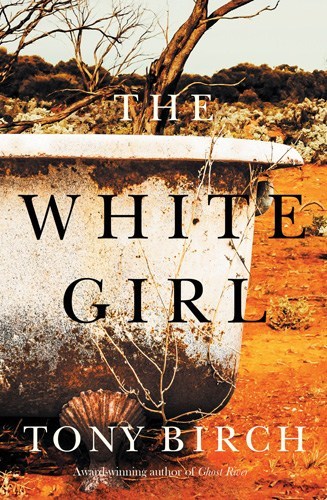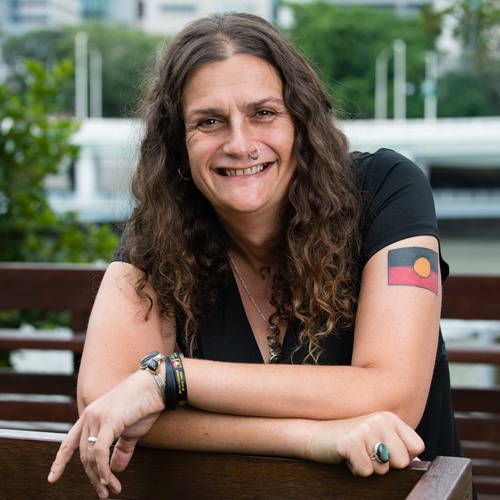During the dystopic aftermath of the apocalyptic invasion of the Australian continent that began in 1788, and has not yet ended, Indigenous women have gone to great lengths to protect children from the men named as ‘Protectors’ of Aborigines, from the police and ‘welfare men’. Children have been hidden, their faces blackened; children have been taken far from home by their own families and not taught culture to ensure they could stay with their loving parents. Children taught culture were in more danger from the Protectors, who were looking for mixed race Aboriginal children to take.
There is another lesser known story, the story of Indigenous people who lied about their heritage to find equality or to protect their children. People I know, or their parents, grew up thinking they were white, Sri Lankan, and First Nations American. I have heard oral histories of people who grew up thinking they were Indian or Southern European. Anything was better, it appears, than being seen by the authorities as ‘Aboriginal’.
How do I know of these hidden children who hid their faces, who lied about who they were, who were lied to about who they were; who were hidden in plain sight? It came to me as oral history, as family history. My father was hidden in this way. I live with the aftermath of my grandfather’s decision, which was the right decision at that time.
My father never knew his grandmother. Laws in Western Australia when he was a child placed him under the auspices of the Department of the Protector of Aborigines, placing him in danger of becoming a member of the Stolen Generation if he was seen associating with Aboriginal people, including his own extended family. And so he grew up believing he was of Fijian descent, told so by his own father. That belief was passed on to me. It was only this millennium that the truth was revealed to my family. It was the first of a cascading series of revelations that led me to my desperate move towards decolonisation and return to culture.
I don’t think anybody knows how many Aboriginal people made the decision to identify their children as ‘not Aboriginal’ to protect them from discriminatory laws and abuses by government, police, and bureaucracies. The long-term effect of these decisions still need to be unpacked, the ramifications of intentional, parental removal of children from culture are still not properly understood. However, this risk, taking children from culture, from Country, from family to protect them from laws we would no longer tolerate was worth taking – to keep the children with family, to keep them safe.
This is the decision that faces Odette Brown in Tony Birch’s fourth novel The White Girl. Is her granddaughter better off on Country, at risk of being taken by the police or the welfare system; or off Country, away from the places where her family has lived for countless years, away from the bones of her ancestors? Culture might not live off Country, in the city, but all culture will be lost if the child is taken; a child taken by the welfare system loses Country anyway, and at the same time they lose their family.
And so Tony Birch, a Koorie man from Melbourne, brings us the story of Odette Brown and her granddaughter Cecilia, also known as Sissy. These Aboriginal women live on the fringes in 1960s Australia, a time when apartheid is about to officially end. Their home is a tumble-down cottage in Quarrytown; an abandoned mining camp on the edge of an imagined small town, one that could be any number of inland towns on the eastern side of the continent.
Deane, the town of which Quarrytown is an appendage, is an Australian Gothic landscape comprised of racists, junkyards, an abandoned quarry, an old decrepit mission, a corrupt and drunk cop, and another who takes his role as ‘protector’ a little too seriously. In this landscape, peopled with men both odious and kind (more of the former rather than the latter), Odette and Sissy join First Nations residents and members of other disadvantaged minorities in a war of survival; not by fighting back or resisting but by demonstrating resilience – by flying under the radar.
There are no memorable or named non-Aboriginal women in the town of Deane. It’s a frontier town and it’s dying: the quarry it was founded on is no longer worked and Quarrytown is already dead. Only Odette still lives there, in Quarrytown, and the nearby mission is completely abandoned to the ghosts. It is white men – the agents of colonisation – and Aboriginal women – the great survivors – who are important to Birch’s story.
It is in towns like Deane that women are most at risk. Rape has always been a weapon of war – particularly in the black war that has shaken most of Australia for centuries – and it is rape that has destroyed Odette and Sissy’s lives. Sissy is a daughter of rape and being a young woman in such a town is also at risk herself.
Odette knows the depth of danger they are in. ‘Trouble? Our people have been in one sort of trouble or another from the first day we set eyes on a white person’. This sentiment is familiar to most, if not all, Aboriginal people. Trouble is life for Aboriginal women, or more accurately life is trouble. The upside of this is that people who survive the trouble become strong.
Aboriginal women are strong. The Aboriginal women of Deane and Quarrytown are paragons of quiet strength, long enduring a dangerous scenario to stay on Country, to stay near the graves in the abandoned mission where the bones and spirits of their families dwell. The mission graveyard has become a sacred site, a place where ancestors can be visited and contacted. It’s an important place to Odette; for a small-town, mission raised woman those graves have achieved a religious status.
The factual and historical basis for this novel is firm, there are a number of missions I am aware of where the Aboriginal residents refused to leave once the mission closed because they have family in the graveyard; Coranderrk, the old mission near Healesville on the outskirts of Melbourne, is one among many of these. When the mission was closed, when the white settlers stole the land again, elders who had family buried in the cemetery stayed until they died. The cultural importance of bones in the ground should not be ignored and forgotten; Aboriginal people do not forget.
Not enough has been written about quiet resilience and silent resistance as tools of survival, about survival of family and continuation of culture as a measure of success. Birch presents this beautifully, engaging his readers in a powerfully straightforward manner. His stripped-back language is a perfect expression of the silent stoicism of the characters. There is an intent in his plain-talking style, an intent to make Odette’s story accessible; to not obfuscate something so important. The terse lyricism of his language reminds me of an Elder teaching culture – of Aboriginal stories and storytelling.
The novel is approachable and fiercely readable, its linguistic and cultural power cloaked in deceptively simple language. Perhaps that is the power of The White Girl, the ability to make the experiences and decisions of the characters, so close to the bone already for Indigenous people, visceral and immediate for an outsider audience.
The White Girl is set in the 1960s, towards the end of the mission days but before the official end of the Stolen Generations (many say the Stolen Generations never ended and the forced removal or Aboriginal children by the state continues today). The 1960s were a dynamic time in Australian politics, culminating in increased equality between Indigenous and non-Indigenous people, the referendum to count Indigenous people in the census and the birth of land rights. Dynamic and dangerous, interesting times present writers with an opportunity for powerful historical fiction. Birch takes up this opportunity and the tensions between characters and within the socio-political landscape in The White Girl are both captivating and inherently storied.
Odette Brown is the grandmother most Aboriginal people have or might wish they had, that many of us might have had without knowing it. She is strength itself, willing to do anything to look after her granddaughter, risking her health for Sissy.
To escape from the psychotic copper, the murderous young men of Deane, and the deeply dysfunctional town itself, Odette must take Sissy away – but there is no legal way for them to travel together. Lila, Sissy’s mother, is in the city and if they can reach her maybe she can look after Sissy.
So they must escape to the distant un-named big city in a conceptual disguise: Sissy as the titular White Girl and Odette as her Aboriginal servant. Hiding in plain sight can be the most effective of disguises. Armed with nothing but a letter that mentioned Lila’s past work-place and money Odette had earned as an artist and squirreled away, they flee to the city.
The story is completely believable. Countless Aboriginal people must have hidden in this way. Odette, with her her stoic power and her grandmotherly love, is just as realistic as the story and the setting; as is Sissy, who is light-skinned enough to pass as white, cheerful and empowered by the strength Odette loans her.
Sergeant Lowe, the new copper in Deane, the psychotically overenthusiastic ‘Local Protector of Aborigines’ is a bogey man from Aboriginal Australia’s past. We all have stories of police like him who, in their rush to enforce the law on those they deem lesser, have caused incalculable harm. He is more like a force of nature than a person, the laws of the 1960s and their bureaucracy made flesh. The laws of the time were impersonal in the removal of the rights of Indigenous people but Lowe takes them personally, makes them personal, turning his responsibility into a sort of crazed over-reaction. He does not take Odette and Sissy’s escape lightly. He does not contact the authorities and allow others to chase the women down; instead, he takes on the task himself and his pursuit of them drives him to the edge of madness.
More decisions need to be made, more risks taken by Odette to protect Sissy when faced by the long arm of ‘welfare’, the force of nature Lowe. He is familiar to most Indigenous people, the over-authoritative powerful white man, the sort of character that my friends and I call a ‘mission manager’. Odette’s decisions are perfectly reasonable and understandable as well, they might shock the non-Indigenous audience but I do not imagine they would easily surprise an Indigenous reader.
Tony Birch has always used his fiction to bring common, average, forgotten people into the light. In his Miles Franklin-shortlisted novel Blood, in intense short-fiction collection Common People, it is the little people – children, the homeless, the poor – who he invokes.
This is particularly true of The White Girl. Odette Brown is nobody special, by most calculations. She is someone willing to risk everything for her grandkids. And we cannot feel anger for the absent Lila’s decision to abandon Sissy and flee to the city. Deane is not a safe place and she reasonably might have felt she had to leave to save her life. She could have genuinely intended to return for Sissy one day.
Birch’s characters could be any of us, are all of us, for we are the common people he writes of; the people in the street, in the suburbs just living they best life they can manage in difficult circumstances.
We follow the common people, because we know they can be any of us, we feel for the common people, for the abjected, the lonely, the Indigenous, the poor, because we know they are doing it hard. Yet, in Birch’s work we do not pity them because he is the master of writing quiet strength, characters who are not advantaged but are perhaps the best of us. Odette Brown is someone we love, someone we feel deeply for, someone we admire. Most importantly she is someone we think we already know – we understand her decisions, her risks, the lengths she goes to and the risks the takes for Sissy and to look for Lila. She is everybody’s grandmother, everybody’s mother, she is who we hope we can become when we are in her position.







